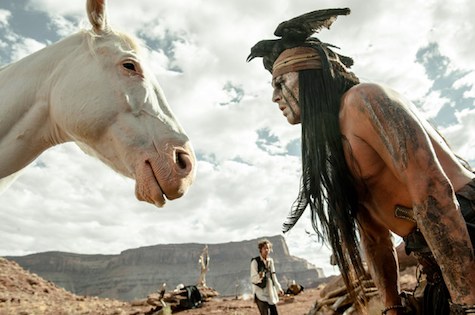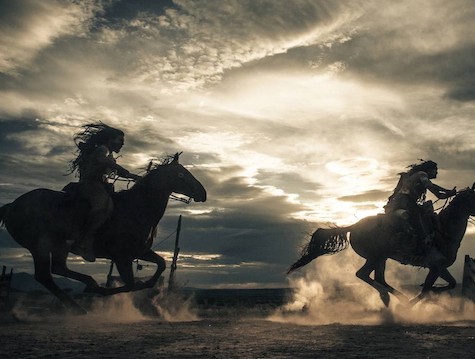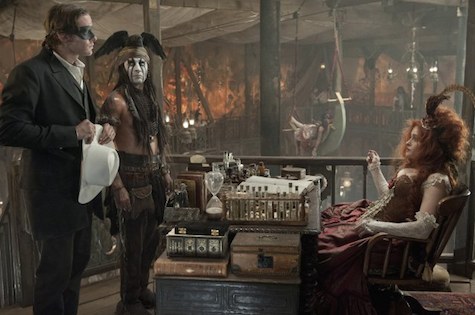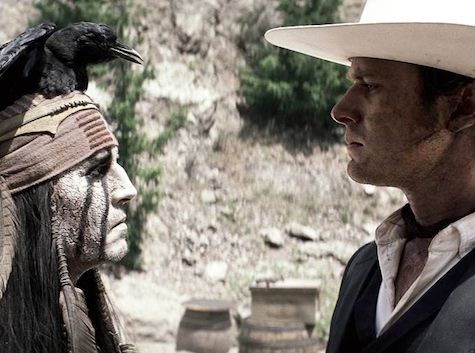All right, first question that everyone has been super concerned about from the beginning: is The Lone Ranger going to push everyone’s racism buttons? After all, frontier stories often have that problem, and the “white guy savior” complex has soured in our collective mouths over the years. When it was announced that Disney planned to revive this old favorite, many were giving this project the side eye and no one could blame them. So were the worries founded?
MILD SPOILERS FOR THE FILM.
First things first: Johnny Depp is still playing Tonto. (Yeah, he’s 1/32 Cherokee or something—yet Jay Silverheels, who played him on the television show over sixty years ago, was a full-blooded Mohawk Indian. So this is not looking so great on the progress front.) That alone might be enough to set your heels sizzling, and that’s completely fair. His makeup as Tonto is inspired by a painting done by Kirby Sattler in 1991 titled “I am Crow,” which does not depict any actual American Indian regalia at all, but was instead dreamed up by the (white) artist. Still not looking so great. Also, he is basically an American Indian version of Jack Sparrow. The bird on his head even looks like his famous leather tricorn from certain angles. Hmm.

Except the movie then goes out of its way to explain Tonto’s backstory and make it clear that his appearance and behaviors have nothing to do with him being an American Indian. All the magic he talks about, all the great spirits he invokes, and all his goofy posturing are affectations meant to guard him against a trauma. We do see actual American Indians in this film, and they are treated with a great deal of dignity and respect without descending into the condescension of “noble savagery.” The truth of how they were treated, framed, and depicted by white settlers is set in stark relief against Tonto’s antics and makes his brand of madness even more understandable—in face of the loss all these peoples suffered, it might be easier to play into stereotypes and let people think you’re a little bonkers. At least then you’ll be left to your own devices more often.
The Lone Ranger’s creed and character guidelines from inception demanded a white knight caliber that has always been too good to be true, and they’ve maintained that standard with Armie Hammer’s lovable-but-now-hapless John Reid. I give a lot of points to Hammer for being willing to play this kind of hero, the one who gets laughs at his expense, but manages it with earnestness and stubborn resolve. He begins the film as a lawyer, the Locke-reading sort who believes in ultimate good and ultimate justice. What’s refreshing is that the movie goes out of its way to prove his brand of justice will not stand in places where men answer to no one. The brains of their operation is clearly Tonto, and the Ranger doesn’t really come into his own until the final twenty minutes of the film.

This handily sweeps aside the “great white guy saving all the little people who need him” trope. It’s (unsurprisingly) similar to the Pirates of the Caribbean gamut—Will Turner’s morality was out of place in a world full of pirates, and Captain Jack let him know that every chance he got. Now Reid’s morality is causing him the same ruckus in this world full of lawless cowboys, and Tonto is more than willing to call him “stupid white man” for it. And truthfully, that’s half the fun of the film.
The villains of the story are the true villains of history: the greedy ones who pushed out into lands they shouldn’t own, ruining ways of life for people they demonized, enslaved, and murdered. The heroes of the film are people whose stories usually aren’t told: people of color, unpaid laborers, prostitutes, and widows, and one single masked white guy who still can’t believe that all the other white men in the world aren’t on his side. More importantly, when the Ranger tries to fight on behalf of others, he’s often told to step aside and let them handle their own business, thanks very much.
Shocking, no?

Tonally, the movie is a bit all over the place. Unlike the Pirates films, which handily balanced dark drama with buffoonery, Lone Ranger’s drama comes from a very real and painful place, making it harder to take the comic tradeoffs when they come. All the same, when the film is on point it’s full of laughs, and the action is appropriately unbelievable at every turn. That unbelievability serves them very well right at the end—after all, if the Lone Ranger and Tonto are legends to us all, their feats should be legendary in size, taking on a peculiar patina that may be the result of an unreliable narrator….
For fans of The Lone Ranger, there are a number of excellent shoutouts and much more. The framing device for the movie is a very old Tonto telling the story to a boy while he’s on display in a sideshow—in the year 1933, the same year that The Lone Ranger premiered on the radio. Reid’s backstory is pretty much identical to his original makings, down to the death of his brother and Butch Cavendish being the first bad guy he faces down. The making of his mask is true to the origin story, but with an extra twist, and silver bullets do play into the tale. The details of how the Ranger obtains and subsequently bonds with his horse Silver steals the movie at several points. Lone Ranger’s theme, now and forever the “William Tell Overture,” is employed expertly at various key points in the story. It’s never overused and every time it begins you get that happy lurch in your chest. In addition, the Ranger’s favorite catchphrase “Hi-yo, Silver, away!” is employed to just brilliant effect.

It sets itself up easily for a sequel, and that will clearly be the film that makes or breaks this reboot—if the next movie doesn’t watch its footing, it will risk making its first attempt look cynical in hindsight. If Reid and Tonto are riding for justice, let’s hope they make their careers by continuing to help those who truly need the most helping. An alternate universe, if you will, where the western frontier was rendered perhaps a bit less bloody due to the help of two friendly strangers. If they manage it, “that masked man” may find a home in our hearts all over again.
Emmet Asher-Perrin has a mother who adored Lone Ranger as a kid, and actually thinks that she might enjoy the heck out of this film. She was recently on the Geeks Guide to the Galaxy podcast talking about Star Trek Into Darkness, and an essay of hers can be found in the newly released Queers Dig Time Lords. You can bug her on Twitter and read more of her work here and elsewhere.










